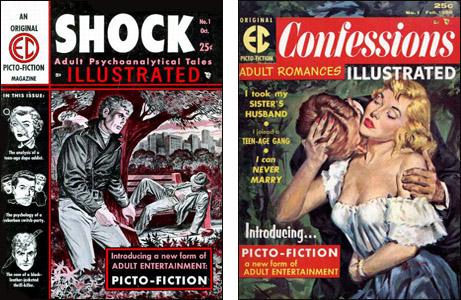Here's a quick bit of Comic Book History: In 1954, EC Comics were being driven from the newsstand. Various parents' groups and factions within our government were pressuring distributors and retailers not to carry "nasty books" like the company's Tales From the Crypt and Shock SuspenStories. Publisher Bill Gaines was forced to kill off his horror and crime comics so he replaced them with more wholesome titles, approved by the newly-formed Comics Code Authority…and you know what? They didn't sell, either. Two problems: The new books weren't all that good, and they said "EC" on their covers. The wholesalers and newsstands still wanted nothing to do with that imprint, and Gaines's "New Direction" line (as he called it) died a rapid death.
Fortunately, Gaines was publishing something else: MAD Magazine. MAD had been a ten-cent comic book for its first two dozen issues but had recently been changed into a twenty-five-cent magazine. A lot of folks seem to think Gaines did the conversion to escape the politics of comic book publishing and the Comics Code…and while that was a happy result, it wasn't the immediate reason for the upgrade. The reason was that MAD's founder-editor, Harvey Kurtzman, didn't want the shame and chintziness of being in comics any longer and was threatening to quit and go work for a slick magazine. Gaines regarded Kurtzman as indispensable to MAD so to keep him on board, MAD became a magazine, which proved to be a workable, successful format.
It prompted Gaines to try re-establishing his old horror and crime material that way…with a romance title thrown in, as well. He and his other main editor-writer, Al Feldstein, launched the Picto-Fiction line: Adult Tales of Terror Illustrated, Shock Illustrated, Crime Illustrated and Confessions Illustrated. They were, like MAD, black-and-white inside. They were, unlike MAD, spectacular failures…and probably for the same two reasons that the "New Direction" line flopped: They weren't all that good, and they said "EC" on their covers. (I once asked Gaines why he put the logo on these books but not on MAD. He shrugged and said, "I don't know…never gave it any thought.")
Inside, the Picto-Fiction books featured clever stories, many of which were adapted from earlier EC Comics. Inside, the Picto-Fiction books featured superior illustration work by the same artists: Jack Davis, Johnny Craig, "Ghastly" Graham Ingels, et al. Alas, it was all in a text and pictures format that just didn't work. They weren't comic books and they weren't fiction magazines. Instead, they combined the worst of both worlds, and it didn't help that newsstands had no idea where to rack them. Sales were disastrous.
For years now, the nine published Picto-Fiction issues have been among the rarest EC collectibles, especially Shock Illustrated #3. It was just coming off the press when Gaines gave up on the line, and he elected to save money and destroy the press run of that final issue, rather than distribute it. So all but 100-200 copies were pulped, and those few went to the staff and a few devoted fans. I've only seen copies from afar, sealed snugly in mylar, and I've never read the issue.
But I will, soon. Russ Cochran, who has republished all the other EC material in quality, hardcover volumes the last few decades, has finally reached the final body of work in the pantheon. Later this year, he and Gemstone Publishing will bring us The Complete Picto-Fiction, reprinting all nine issues plus 17 never-before-published stories that were left homeless when the Picto-Fiction line crashed and burned. Like Cochran's previous sets, this will be a quality, slipcased edition that will sell for a hefty pricetag. We don't yet know what that pricetag will be but it will be worth it. It always is.
